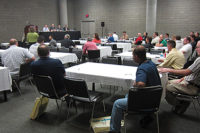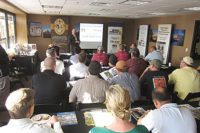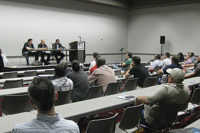StonExpo, which is part of The International Surface Event (TISE) – a stone, tile and floor covering exhibition held annually at the Mandalay Convention Center in Las Vegas, NV – provides an arena for fabricators from various regions of North America to gather together to share ideas and experiences, learn about new products on the market and to meet new people. The exhibition also has an educational component that includes a Fabricator Forum, which is open to all industry members. The hour-long session encourages audience participation. It is an ideal setting for those new to stone fabrication to ask questions from an experienced panel of industry veterans. Moreover, it allows those who have been in the industry awhile to talk out issues they are having and receive advice on how to deal with them.
This year’s Fabricator Forum: Networking, Learning, Sharing was well received, with a full room of industry members. Those on the panel included:
- Gasper (GK) Naquin, president of Stone Interiors with locations in Alabama, South Carolina and Louisiana (moderator)
- Karen Roe, owner of NSMotif in Sanford, FL
- Jorge Gonzalez, founder of JG Natural Stone, LLC in Fort Worth, TX
- Joey Ganassa, vice president of Washington Marble & Granite Co. in Ijamsville, MD
To kick the forum off, each member of the panel briefly spoke about topics they will address during the session. “How many people do big box stores?” asked Naquin. “I have probably a couple hundred between our three locations. They are very demanding, but give you volume.”
Naquin went on to say that he has found there is not a problem with the fabrication end at his company, but rather with the sales staff relaying all the pertinent information for a job.
Roe stated she is aware of the OSHA laws out there that fabricators are concerned about, and she intended to talk about that more in depth. “I always like talking about challenges and see how they are being handled,” said Ganassa.
Backlighting an island
The first audience participant explained he had a request for large islands made with translucent materials backlit with LED lighting. “This is a challenge I have,” he said. “I want to get an idea what other people are doing. I couldn’t think of any solution for it.”
Roe explained that in Florida, she doesn’t backlight many islands. “We have done some backlit work maybe on vanities,” she said. “There are some good lighting companies out there that won’t give you a line. I recommend you talk to them. It’s not their first rodeo. They will know what will work and what won’t.”
“I actually won a Pinnacle Award for backlighting a bar with onyx,” said Naquin. “There are a couple of good LED companies out there. I found a company that makes a 12 x 12 that doesn’t have a shadow panel. You can light up the whole island pretty easily. You need an electrician to bring the power to the island.”
The audience member said he needed to make sure he has the right adhesive, and Naquin explained for an island that size you [can use silicone for the lights.] “There are glues out there that are translucent,” he said. “I recommend going to one of the bigger suppliers out there. You don’t want to use a polyester because it yellows.”
Offsetting costs
Another audience member inquired how others offset their costs? “I need help with high-end machinery,” he said. “Over the years, I have invested in a CNC saw and CNC router. I need help how to offset my costs. My competition has already had it for years. I have had it a year, but I am still trying to adjust my costs. How much water it needs? How much for the person to operate it? I have a problem translating the dollar to the customer so it covers it. I don’t want to go too cheap and flip it for nothing, but I want to be competitive to my competitor.”
“My first response is don’t drop your price,” said Roe. “You are going to put yourself out of business if you don’t cover your expenses. Give yourself something in that no one else in the area does. Sell on your experience. Once you make that connection, they won’t care what the price is. What makes it personal to that person? Don’t focus on what your competitors are doing as far as price goes. Focus on what you need to do as an entrepreneur to make your business successful.”
“What’s your core business?” asked Naquin. “Who do you sell to?” The participant said his primary clients are builders, designers and walk-ins. “What percentage of that market do you own?” asked Naquin. The fabricator said 25%. “Why don’t you go to the next market,” said Naquin. “Go to retailers. You need to fill the boat a little bit more. My goal is that I always want to go find the business. Look at the market share and see where you stand. Stop looking at how much I have in my equipment but how much am I bringing in?”
Ganassa said he loses count at 50 fabricators in his area. “You have to be competitive, but you have to know your costs and set your price,” he explained. “I have spreadsheets for every month. When it comes to what you are talking about, try to get new business. There’s not just builders. There are architects, designers, people who don’t care about costs. You have to know there are tons of different customers out there and who you are serving.”
Scheduling issues
Moving on, another audience member brought up the subject of scheduling. “Our shop does 700 to 900 square feet a week,” he said. “I’m bottle necked on the scheduling. We just got a CNC saw. We are growing so big, so fast. Before we were like here is your template date, fabrication date. What do you do? Do you just give a template date? How do you do your scheduling?”
Roe said her company is six to eight weeks out, and they give a template date. “The bottleneck is when builders aren’t ready,” she said.
“I have been doing scheduling for the company for the last eight years,” said Ganassa. “I just hired someone recently to do it. We believe in being very flexible. Builders often come in the day they need something. We can’t tell them we can’t help them for two weeks. We have a goal of doing a countertop in about one and a half weeks. We have Moraware. I look at it every day. Sometimes every couple of hours. You always have to look at it. That’s how I like to do it.”
Roe stated she believes it depends on the customer. “When dealing with a builder, we are turning things five days from template,” she said. “For big box stores, we are 14 days from templating.
We have a process in place. Our sales people get all the information up front. If they don’t get all the information, then we don’t schedule it. We use Stone Profits. We used Moraware for a long time, but as we grew, we wanted to drill down on our costs. Stone Profits is better for us.
“There’s not going to be a set in stone thing,” Roe went on to say. “We confirm 24 hours before install. We make sure the cabinets are in place, etc.”
“I believe scheduling is the hardest part of our business,” Ganassa added.
“Our biggest problem with scheduling is not having the information to put in there,” said Naquin. “If a builder, designer or retailer doesn’t give me the integrity to tell me all the information, then how am I going to have the integrity to trust them and give them a date?”
“The follow up to that question is ‘How do you deal with contractors that aren’t there and ready for you when all the pre-calls are telling the sales people it’s ready?’” asked the same audience member.
“GK makes a good point,” said Roe. “It should go back to the sales people. I need to know the edge profile. That’s not a decision made on site. Sales people really need to gather all of the information. If I have a customer say ‘Yes, we are ready,’ and I have all the information and then I get there and cabinets aren’t attached to the wall or aren’t even there and the builders haven’t even looked at it, we charge a trip charge. Time is money. When you confirm your appointments 24 hours before, your contract has to say these things need to happen and if not, you will be charged.”
Digital templating
The discussion during the forum then turned to a technical side. “We try to do kitchens by measuring templates on top of the countertops,” said a participant. “By going digital, will it make those challenges easier? Can I use the machines to do everything I need without touching the kitchen?
“We have a Proliner,” said Ganassa. “It’s a no brainer.”
“When you get it done it’s a lot better, but it takes some time to get it right,” said Gonzalez. “Going digital has been great, but we are small and can’t afford to get one measurement wrong. You need to keep an eye on that.”
“Jorge makes a good point,” said Ganassa. “You have to be careful with the files. The way you are saving and labeling them. If you pull the wrong file, there can be problems. Organization is important.”
“We have one of each — a Proliner and a Laser Templator. Once you get into that world, training is key. One mistake can be pricey, but it’s faster.”
Fabricating alternative material
As it does often these days, the topic of working with alternative materials to natural stone and quartz surfacing came up. “How are you adjusting to your fabrication with new materials coming into the market?” asked an audience member. “It’s hard on our fabrication process because there is different tooling.”
“We have been doing all of that too,” said Ganassa. “There are so many blades out there. It’s going to throw your schedule off big time. There’s lots of experimenting. A lot of these [manufacturers] give you free slabs. We are certified in Dekton, and they came out and trained us and gave us two slabs.”
Roe explained that her shop designates one day a week for cutting all its Neolith and Dekton projects. “We obviously don’t produce as much,” she said. “I don’t turn a Dekton kitchen in five days. No way. It takes two weeks. Set that expectation.”
“We were the first one to bring in Dekton and Neolith,” said Naquin. “It was very expensive for us to learn. We were the first generation. It is much slower to cut those products — even with the waterjet. You have to really plan your scheduling. If I have an ultra-compact material or quartzite, I make sure I give my shop the lead-time to cut it. I give them a head start and tell them we are installing in three weeks. Typically a job goes through our shop in two and a half hours — not with Dekton.”
An audience member asked panel members to share the percentage of work they have with Dekton? “Are you charging a percentage more for those materials?” he asked.
“I believe every market is different,” she said. “What I can sell Dekton for might be different in California. We charge a minimum of $45 a square foot just for labor. It’s a pretty good price. It covers our cost.”
Naquin explained he believes Dekton and porcelain slabs are excellent materials. “They aren’t going away. There is a lot of tension in some of these materials.”
“That’s why we charge so much,” said Roe. “I have yet to do a Dekton project where a slab didn’t crack.”
The participant asked if the panel members charge by the square foot or per job. “Everyone said, ‘Per job.’”






